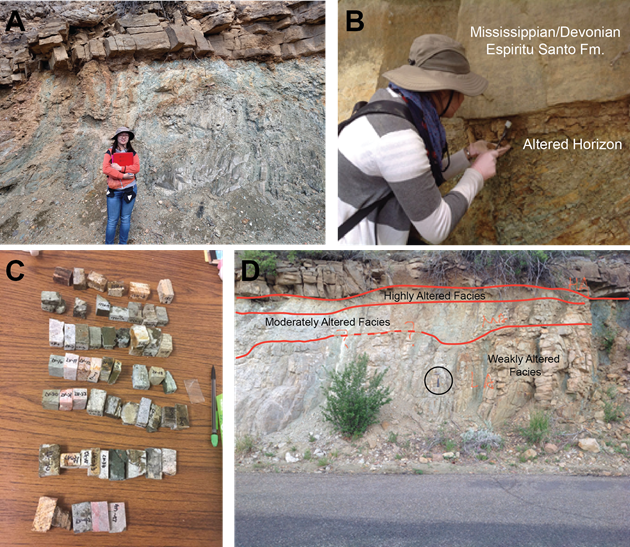Reports: DNI256958-DNI2: Origin of Altered Horizons beneath Nonconformities: Implications for Induced Seismicity and Basin-Scale Fluid Flow
Chloe E. Bonamici, PhD, New Mexico Tech
Funding through the PRF’s Doctoral New Investigator program this year has allowed Dr. Bonamici to recruit her first graduate student as a new assistant professor. Ms. Ke Li obtained her B.S. in Earth Science from New Mexico Tech in December 2016 (Fig. 1A). She was accepted to the graduate program of the Department of Earth and Environmental Science in January 2017 and has been pursuing a course of study designed to develop her expertise in physical chemistry, fluid geochemistry, and petrographic and geochemical analysis. In addition, Ms. Li has actively and independently sought out coursework to improve her scientific writing, an area that she views as very important to her future career, as she hopes to work as a geoscientist in the petroleum industry.
Since January, Ms. Li and Dr. Bonamici have made significant progress in the following project tasks:
1. Field characterization of the altered horizon along the Great Unconformity in Gallinas Canyon, NM.
2. Sample collection for geochemical analysis.
3. Sample preparation for geochemical characterization.
4. Preparation for upcoming fieldwork at the proposed Grand Canyon Great Unconformity site.
Dr. Bonamici worked with Ms. Li over five days in April and May mapping, describing, and collecting samples along the Gallinas Canyon Great Unconformity altered horizon outcrops. Ms. Li spent a further five days in June conducting independent fieldwork with a field assistant to complete characterization and sample collection at this site (Fig. 1D). In all, we collected a suite of 59 rock samples representing the range of altered and unaltered lithologies along the Gallinas Canyon Great Unconformity (Fig. 1B). Ms. Li prepared these samples for geochemical analysis by carefully splitting them, with one portion for whole-rock geochemistry and the other for geochemical microanalyses. The whole-rock sample portions were sent to the Washington State University Geoanalytical Lab for major-, minor-, and trace-element analysis. A fraction of each microanalysis sample was cut into a thin section billet and sent to a professional service for final thin section preparation (Fig. 1C). Whole-rock data and thin sections will be returned for data analysis later this fall.
While awaiting the return of whole-rock data and thin sections, Ms. Li has been preparing for fieldwork at the second Great Unconformity field site in the Grand Canyon. This site is located inside Grand Canyon National Park and we must obtain permission from the National Park Service (NPS) to work there. The NPS has a standardized application process that requires submission of a combined scientific and work proposal. Ms. Li (with Dr. Bonamici’s guidance) has been writing this proposal, using her experience with the Gallinas Canyon field site as a guide, and she plans to submit it for consideration in late October. Pending approval of the NPS, Grand Canyon fieldwork is planned for spring of 2018, when temperatures will be mild and working conditions will be safest. In the event that permission is not granted, Dr. Bonamici has identified an alternative site for work on the Great Unconformity in the Peach Springs drainage of the western Grand Canyon area that is on Hualapai tribal land. The Hualapai tribe has a record of cooperating with government science personnel to allow access to the Colorado River and the lower Grand Canyon reach.
An important product of field work this spring was the development of mapping criteria for different degrees and types of alteration (alteration facies) within the altered horizon at the macro-/outcrop scale (Fig. 1D). These alteration facies provide a contextual framework for sampling rock units for microscale geochemical analysis. They are also an important tool for tying future microscale geochemical analyses to outcrop-scale rock properties, which ultimately determine their mechanical and fluid behavior. The alteration facies definitions will also allow us to provide future workers with criteria for identifying geochemical processes that have affected altered horizons based on outcrop or core samples in cases where microscale studies are not tractable.
Figure 1. Photographs demonstrating 2017 activities on PRF project on altered unconformity horizons. (A) Graduate student Ke Li during spring field work along the Great Unconformity in Gallinas Canyon, NM. (B) Ms. Li samples the Highly Altered facies of the altered horizon immediately at the Great Unconformity. (C) Thin section billets prepared from Gallinas Canyon samples. (D) Example of tablet-based digital outcrop mapping of different alteration facies within the altered horizon at Gallinas Canyon. The Highly Altered facies is recognized by the complete replacement of original crystalline fabrics and textures by a granular to fissile texture, development of a secondary, subhorizontal fabric defined by alignment of clay or mica grains, and abundant mineralized veins and oxidized mineral grain coatings. The Moderately Altered facies retains some of the original bedrock textures; it shows localized secondary clay alignment fabrics, as well as less pervasive veining and oxidation. The Weakly Altered facies is recognized by good preservation of original crystalline bedrock fabrics with a spaced, subhorizontal cleavage or fracture, and rare mineralized veins and oxidations coatings. Rock hammer (circled) for scale.












